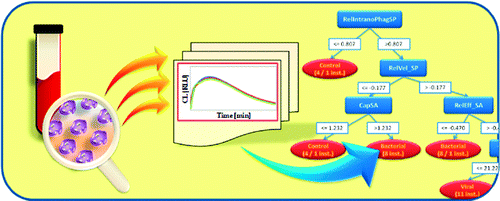New rapid test tells difference between bacterial and viral infections

Scientists are reporting development and successful testing of a rapid and accurate test to tell the difference between bacterial and viral infections. Those common afflictions often have similar symptoms but vastly different treatments — antibiotics work for bacterial infections but not for viruses. The report appears in ACS' journal Analytical Chemistry.
Robert Marks, Daria Prilutsky, and colleagues cite the importance of determining the source of an infection in order to quickly start the right treatment. If left untreated until results of a throat culture, for instance, are in, bacterial infections can get worse. But needlessly giving antibiotics to patients with a viral infection could contribute to the growing problem of antibiotic-resistant bacteria. Since current diagnostic methods to sort out the two kinds of infection are time-consuming and may not be completely accurate, the researchers sought to develop a new test that would enable doctors to rapidly make the right diagnosis.
They found that the immune systems of patients with bacterial infections behaved differently than the immune systems of patients with viral infections, and developed a test based on those differences. "The method is time-saving, easy to perform and can be commercially available, thus, having predictive diagnostic value and could be implemented in various medical institutions as an adjunct to clinical decision making," say the researchers.
More information: “Differentiation between viral and bacterial acute infections using chemiluminescent signatures of circulating phagocytes” Anal. Chem., 2011, 83 (11), pp 4258–4265 DOI: 10.1021/ac200596f
Abstract
Oftentimes the etiological diagnostic differentiation between viral and bacterial infections is problematic, while clinical management decisions need to be made promptly upon admission. Thus, alternative rapid and sensitive diagnostic approaches need to be developed. Polymorphonuclear leukocytes (PMNs) or phagocytes act as major players in the defense response of the host during an episode of infection, and thereby undergo functional changes that differ according to the infections. PMNs functional activity can be characterized by quantification and localization of respiratory burst production and assessed by chemiluminescent (CL) byproduct reaction. We have assessed the functional states of PMNs of patients with acute infections in a luminol-amplified whole blood system using the component CL approach. In this study, blood was drawn from 69 patients with fever (>38 °C), and diagnosed as mainly viral or bacterial infections in origin. Data mining algorithms (C4.5, Support Vector Machines (SVM) and Nave Bayes) were used to induce classification models to distinguish between clinical groups. The model with the best predictive accuracy was induced using C4.5 algorithm, resulting in 94.7% accuracy on the training set and 88.9% accuracy on the testing set. The method demonstrated a high predictive diagnostic value and may assist the clinician one day in the distinction between viral and bacterial infections and the choice of proper medication.
Provided by American Chemical Society














